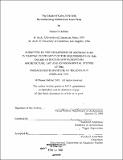| dc.contributor.advisor | Stanford Anderson. | en_US |
| dc.contributor.author | Rabbat, Nasser O. (Nasser Omar) | en_US |
| dc.coverage.spatial | f-ua--- | en_US |
| dc.date.accessioned | 2005-08-10T22:59:51Z | |
| dc.date.available | 2005-08-10T22:59:51Z | |
| dc.date.copyright | 1991 | en_US |
| dc.date.issued | 1991 | en_US |
| dc.identifier.uri | http://hdl.handle.net/1721.1/13706 | |
| dc.description | Thesis (Ph. D.)--Massachusetts Institute of Technology, Dept. of Architecture, 1991. | en_US |
| dc.description | Includes bibliographical references (leaves 273-286). | en_US |
| dc.description.abstract | This dissertation reconstructs one of the major works of military and palatial architecture in the Middle Ages, the Citadel of the Mountain (QaI'at aI-Jabal) in Cairo. It traces its development from its inception in 1176 under Salah aI-Din al-Ayyubi until it reached its definitive and most monumental form under aI-Nasir Muhammad (1293-1341, with two interruptions). The dissertation focuses on the part of the Citadel called today the southern enclosure, which was the residence of the sultan, and of which only the congregational mosque remains standing. It analyzes the different stages of its topographic and architectural development using primarily references collated from the chronicles, biographical compendia, and legal documents of the Mamluk period, and secondarily surface archeology, toponymy, and typological comparisons with extant Bahri Mamluk palaces in Cairo. Through the reconstruction of the Citadel, the study addresses a number of wider methodological and historical issues. It evaluates the influence of the Mamluk socio-political hierarchy on the structure of the palatial complex and on the conceptualization of its spaces and forms. It stresses the importance of construing the architectural vocabulary of the period in its proper historical context. And finally, the dissertation questions the modern perception of the architectural development in a medieval Islamic environment by emphasizing the difference between its secular and religious architecture, and by showing how this perception is disproportionately molded by the latter. | en_US |
| dc.description.statementofresponsibility | by Nasser O. Rabbat. | en_US |
| dc.format.extent | viii, 358 leaves | en_US |
| dc.format.extent | 38013537 bytes | |
| dc.format.extent | 38013292 bytes | |
| dc.format.mimetype | application/pdf | |
| dc.format.mimetype | application/pdf | |
| dc.language.iso | eng | en_US |
| dc.publisher | Massachusetts Institute of Technology | en_US |
| dc.rights | M.I.T. theses are protected by copyright. They may be viewed from this source for any purpose, but reproduction or distribution in any format is prohibited without written permission. See provided URL for inquiries about permission. | en_US |
| dc.rights.uri | http://dspace.mit.edu/handle/1721.1/7582 | |
| dc.subject | Architecture | en_US |
| dc.title | The Citadel of Cairo, 1176-1341 : reconstructing architecture from texts | en_US |
| dc.title.alternative | Reconstructing architecture from texts : the Citadel of Cairo, 1176-1341 | en_US |
| dc.type | Thesis | en_US |
| dc.description.degree | Ph.D. | en_US |
| dc.contributor.department | Massachusetts Institute of Technology. Department of Architecture | |
| dc.identifier.oclc | 24343680 | en_US |
